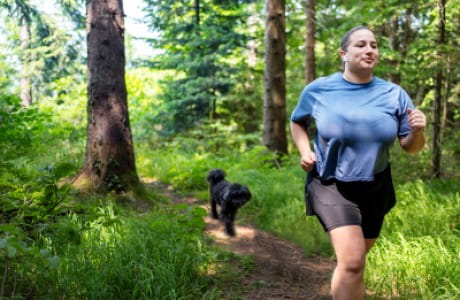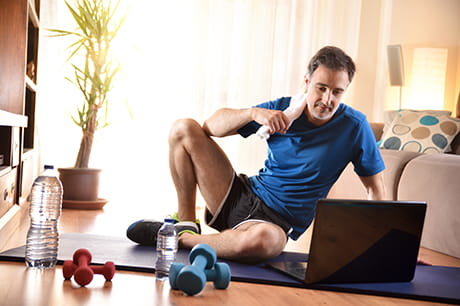Walking or running: Which is better for your health?
When it comes to the highly contested debate on running vs. walking, simply moving your body is what matters most.
If you’re looking to give your fitness routine a cardio boost, you may be wondering whether walking or running is the better option. But when it comes to your health, it doesn’t need to be an either/or decision.
Walking and running are both excellent forms of cardiovascular exercise that offer crucial physical and mental health benefits. Cardiovascular exercise is proven to decrease the risk of heart disease, diabetes, obesity and some cancers — even increase your life span — while also reducing the risk for mental health issues, like depression.
“The decision should come down to your personal fitness goals, health conditions and what you enjoy most,” says Laryssa Richards Loncar, DO, a sports medicine specialist at Geisinger. “The best exercise is the one you’ll do and stick with over the long haul. Whether walking or running, moving your body is the best thing you can do to improve your heart health, stamina and overall well-being.”
Running vs. walking: Key differences to consider
Before lacing up your sneakers and heading outside, there are some key differences to consider when choosing between walking and running:
Impact on joints
Walking is a low-impact exercise, so it puts less stress on your body. When you walk, you have one foot on the ground at all times. But while running, you’re in the air during each stride. Every time you land, your body absorbs the impact of about three times your body weight. This repeated pounding of the feet against the ground can place significant strain on the feet, ankles, knees and hips. For this reason, walking is a better choice if you have arthritis, knee issues or other joint concerns.
“That doesn’t mean running is bad for healthy joints, however,” says Dr. Loncar. “Running helps strengthen the muscles around your joints to provide support and stability. Research has shown that running does not cause osteoarthritis.”
Weight loss
While both walking and running reduce your risk for obesity, running is just more efficient. It’s a great option for burning the most possible calories in a shorter amount of time. In fact, running burns about double the calories per minute than walking does.
According to the American Council on Exercise, on average a person who weighs 160 pounds will burn 15.1 calories per minute running and 8.7 calories per minute walking. That’s equivalent to burning 453 calories running for 30 minutes versus burning 261 calories walking for that same amount of time.
“Walking can be a good exercise for weight loss, too, as long as you’re getting your heart rate up,” says Dr. Loncar. “To do so, increase your pace to a brisk walk and include inclines in your route.”
Heart health
Studies show brisk walking can lower your risk of high blood pressure, high cholesterol and diabetes — all factors that contribute to better heart health — the same as running can. But while both activities contribute to a healthier heart, it just takes more time to reach that goal when you walk. You’ll need about 150 minutes of brisk walking each week, compared to only 75 minutes of running weekly to reach this goal.
Lung health
While both brisk walking and running can improve lung health, running is the better option here. Running is a high-intensity workout and gets your heart rate up closer to maximum levels, when compared to moderate-intensity exercise, like brisk walking. When you run, you breathe more deeply and rapidly, which helps to improve lung function and increase lung capacity.
Running also can help strengthen your respiratory muscles, which can make it easier to breathe and improve overall lung function.
Muscle and bone strength
Weight-bearing exercise, such as walking and running, slows down bone loss and improves bone density. However, high-impact activities like running are slightly better for building bone strength and muscle. That’s because running requires more force, energy and power than walking.
“Running may help improve muscle strength and endurance more than walking, but both activities can help reduce the risk of osteoporosis, falls and fractures,” says Dr. Loncar.
Longevity
While both walking and running are associated with a reduced risk of all-cause mortality — meaning they can help you live longer — running performs slightly better in this category.
A recent analysis of physical activity by the American Heart Association found that people who followed the current guidelines of 150 minutes of moderate-intensity exercise each week had up to a 21% lower risk of mortality from all causes. Those that followed the recommendations for 75 minutes of vigorous exercise weekly had a 19% lower risk for all-cause mortality. People who performed longer than these recommendations had further reduction rates in all-cause mortality.
“Moving your body, whether walking or running, every day for at least 30 minutes will improve your health and increase your life span, especially as you get older,” says Dr. Loncar.
Running vs. walking: Which is right for you?
When deciding which activity is right for you, there are several factors to consider, including your fitness goals, health conditions and personal preferences.
If you are new to exercise, overweight or have joint problems, walking may be a better option for you. Walking is low impact, easy on the joints and can still provide a significant cardiovascular workout. You can gradually increase the intensity and duration of your workouts as your fitness level improves, eventually transitioning to running if that’s your goal.
If you prefer high-intensity workouts, want to lose weight and improve your cardiovascular fitness, running might be the better option. Running burns more calories and can help you lose weight more quickly than walking. It’s also better for building endurance. Just make sure to start slowly and gradually increase your speed and distance to avoid injury.
“It’s important to consider your personal preferences, too. Exercise and health benefits shouldn’t feel like a job,” says Dr. Loncar. “Some people enjoy brisk walking and hiking, while others enjoy running more. Still, others prefer walking and running intervals together. If you’re not sure which activity you prefer, try both and see what you like best. The key is making exercise more enjoyable, so you’ll stick with it.”
Tips on getting started
Getting started on a new exercise routine doesn’t have to be daunting. Following a few simple tips can make it easier and more enjoyable.
Just remember: Before starting any exercise, always talk to your provider first, especially if you have underlying conditions.
Dr. Loncar offers these tips if you’re just starting out:
- Start slow and set realistic goals. If you're new to exercise, don't try to run a marathon right away. Start small, like setting a goal to walk or run for 20 minutes three times a week. Then challenge yourself by gradually increasing the duration and intensity of your workouts as your fitness improves.
- Get the right gear. Choose shoes that are supportive and comfortable with proper cushioning, and wear comfortable, weather-appropriate clothing that won’t restrict your movement.
- Track your progress. Use a fitness tracker or app to track your progress. Be sure to celebrate when you reach your goals.
- Get a workout buddy. Exercising with a friend not only makes it more fun, but also helps to keep you motivated and accountable.
- Take steps to avoid injury. Warm up before exercise, start slow and increase distance and speed gradually to help your body adjust. If you feel pain, stop and rest. Don't push yourself too hard, or you could end up injured.
“Whether you walk or run, as long as you’re getting out there and up off the couch, you’ll reap the rewards,” Dr. Loncar says.
Next steps:
Learn more about orthopaedics and sports medicine at Geisinger
Here are five more benefits of walking
Ready to start running? Here’s how to take care of your feet





